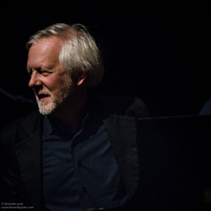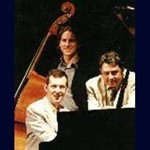by Dick Edelstein

Catalan jazzman Ignasi Terraza and his trio lit up Barcelona with eight sets in October at Jamboree, a cutting edge Gothic Quarter club in the neoclassically-styled Plaça Reial, once an historic crossroads of the Camino de Santiago with the Roman Via Augusta, now a nexus of Barcelona night life and the local jazz scene. The series marks the 25th anniversary of the first Jazz a les Fosques concert that the blind pianist performed in darkness, letting listeners share his sensory experience and gain insight into his musical sensibility.
Anyone who can walk in someone else’s shoes is either a saint or a specially sensitive individual, so when Terraza joked that being sighted is overrated, the audience caught the irony, insanely proud of his accomplishment as the leading exponent of Catalan jazz. His compatriot Tete Montoliu once burnished Catalunya’s image, like cellist-composer Pau Casals, whose Cant dels ocells is broadcast worldwide from Camp Nou football matches to mark a moment of silence for departed socis. Four decades ago in San Francisco, when I told a local jazz musician that I was moving to Barcelona, he replied “That’s in Catalunya—that’s where Tete Montoliu lives”.
In a darkened room, listeners tune in to the way a sightless pianist apprehends music synesthetically, as a cymbal crash becomes a circular pyrotechnic light-burst. Drummer Esteve Pi plays with a clarity that is melodic, architectural, economical, calibrated and precise, limning the structure of his discourse, not just in solos, also in ensemble parts. The trio’s limpid playing is framed by Swiss-Greek bassist Giorgos Antoniou’s supple bass lines and subtle styling; and on opening night, guest singer Laura Simó surprised listeners with a crystalline enunciation of English syllables that added an attractive twist to her interpretation of Billy Strayhorn’s romantic recitative ballad “Lush Life”, a jazz standard whose stock goes up with each new generation. Other nights, rising-star trumpet player Joan Mar Sauqué and Australian clarinet-flautist Adrian Cunningham created unexpected sounds with their instruments, formless textures that eventually resolved into structure.
Each concert starts with the lights on for the first number; after that four tunes march and waltz around in darkness before the lights come up again for a few minutes. The trio then launches into a final blacked-out set, joined at the end by a mysterious guest who sticks around for one final tune with the lights on.
Visitors to Barcelona are enthusiastic about the vitality of the city’s jazz scene, infused with a rich musical culture and a setting that has always been in the swing of things in every genre from opera to hip hop. When Paris was an important new music center, Mompou, Montsalvatge and other Catalan composers drank at the wellspring of Iannis Xenakis, György Ligeti and the rest of the vanguard. Music in Catalunya is enriched by the history of neighborhood choral societies, marching bands, and other musical groups, spread throughout all levels of society and culture, dating back to the early nineteenth century and beyond. And the Sardana, sometimes called one of the most complete musical forms, animates outdoor communal dancing, a group activity with strong cultural significance, but it can be an orchestral suite too and uses woodwind, string and brass instruments that are featured in jazz orchestras. Today, Barcelona’s jazz scene, with several serious jazz clubs and a large number of venues that program jazz in the mix, has overlapping festivals, and the same is true of the villages, towns and cities in Catalunya. After a 15-year stint as a New York jazzman, Cunningham, who has already recorded with Ignasi Terraza, is settling comfortably into the Barcelona jazz scene.
Talking about identity can be uncomfortable, but since I need to touch on it, I’ll use the example of Pep Guardiola, the universal Catalan. A theatre near my home programs mostly in Catalan and I go occasionally, but Pep, who lives 1300 kilometres away, is there regularly, according to the newspapers. I didn’t spot him last night, probably tucked into one of those VIP boxes. I just barely speak Catalan, but he is fluent in quite a few languages. He was still perfecting his English in New York while he was negotiating with the Germans to coach the Bayern Munich football team. And as a young man he was ultra-talented and strikingly handsome. So how can I hold my head high living on Pep’s turf? It’s simple; I’ve got me, a unique identity no one else can claim. Catalans were denied their identity, culture, and language under Franco, and they didn’t like it. This is a palpable force you can feel when Ignasi Terraza plays at home.
Instead of discussing Terraza’s style by referring to influential jazz pianists, it’s better to say he mostly sounds like Ignasi Terraza and carefully chooses his influences with very interesting results; he’s partial to clear, rounded melody lines, like the Bel Canto composers whose arias resound across the street in the Liceu opera house. With his impeccable technique, he can choose to go in any direction stylistically when the mood strikes him, sounding fresh because he doesn’t particularly follow the crowd. His playing is attractive to listeners of my generation because he can swing hard, with accentuated phrasing and driving rhythms, and, in a discrete and knowing way, cheekily adding in funky blue notes born in the USA, where musicians who were cultural heroes risked their lives in the war and came back home to hear people calling their jazz “monkey music” while white bands brewed up a sanitized version of swing that left black musicians unemployed. The bottled-up creativity had to go somewhere, and it fed into formulas with new sets of rules as a sign of identity, marginally respectable but hard to fault musically. Terraza, a good listener with a keen ear, shows that he understands all of this. Interested fans can see what I mean by listening to his recordings distributed through his own record company.
Jazz a les Fosques – Jazz In the Dark
In the darkness … lies clarity. Everything Ignasi Terraza likes is clear: the sound of the Yamaha piano, the way he strikes the keys to get a lively, transparent sound, the way he states the melody before improvising a few choruses, even those 40s tunes he likes, and the chords he plays, often leaving out a few modern harmonic elements to get a rounder, cleaner sound. If this limpid playing sometimes results in a retro style with a modern twist, so what? Born in the 40s myself, I can say there’s plenty a good tune in that old fiddle; just listen to Nat Cole on piano, or Ray Charles, or Fats Waller.
At this stage in his career, Terraza deserves to be respected for being himself, not an heir to a dream team of 1950s piano players. James P Johnson, one of the greatest American pianists, often dared to slip between the classical music he loved to compose and the blues or jazz arrangements he was paid to play, and Ignasi Terraza, with his classical training, does this too. Then, amidst the shining unison chords, and the big block chords he sometimes plays, his limpid, melodic improvisation sometimes reminds me of the ultra-clean sound of alto sax star Art Pepper when he is playing a solo. With style, technique and background, and with the genuine humble respect that so many—but certainly not all—jazz musicians have, Ignasi Terraza is self-contained but a complete package.

